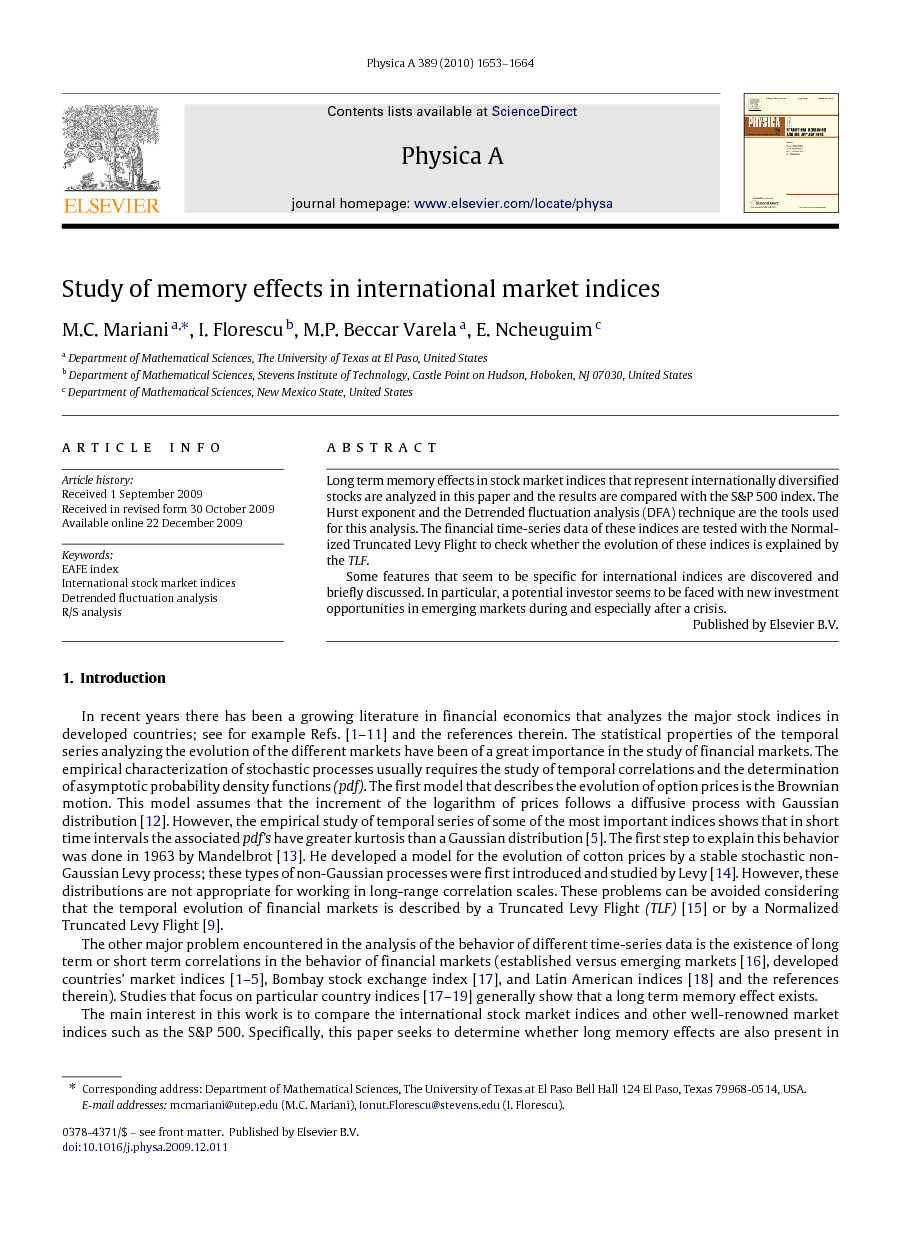Long term memory effects in stock market indices that represent internationally diversified stocks are analyzed in this paper and the results are compared with the S&P 500 index. The Hurst exponent and the Detrended fluctuation analysis (DFA) technique are the tools used for this analysis. The financial time-series data of these indices are tested with the Normalized Truncated Levy Flight to check whether the evolution of these indices is explained by the TLF.
Some features that seem to be specific for international indices are discovered and briefly discussed. In particular, a potential investor seems to be faced with new investment opportunities in emerging markets during and especially after a crisis.
In recent years there has been a growing literature in financial economics that analyzes the major stock indices in developed countries; see for example Refs. [1], [2], [3], [4], [5], [6], [7], [8], [9], [10] and [11] and the references therein. The statistical properties of the temporal series analyzing the evolution of the different markets have been of a great importance in the study of financial markets. The empirical characterization of stochastic processes usually requires the study of temporal correlations and the determination of asymptotic probability density functions (pdf). The first model that describes the evolution of option prices is the Brownian motion. This model assumes that the increment of the logarithm of prices follows a diffusive process with Gaussian distribution [12]. However, the empirical study of temporal series of some of the most important indices shows that in short time intervals the associated pdf’s have greater kurtosis than a Gaussian distribution [5]. The first step to explain this behavior was done in 1963 by Mandelbrot [13]. He developed a model for the evolution of cotton prices by a stable stochastic non-Gaussian Levy process; these types of non-Gaussian processes were first introduced and studied by Levy [14]. However, these distributions are not appropriate for working in long-range correlation scales. These problems can be avoided considering that the temporal evolution of financial markets is described by a Truncated Levy Flight (TLF) [15] or by a Normalized Truncated Levy Flight [9].
The other major problem encountered in the analysis of the behavior of different time-series data is the existence of long term or short term correlations in the behavior of financial markets (established versus emerging markets [16], developed countries’ market indices [1], [2], [3], [4] and [5], Bombay stock exchange index [17], and Latin American indices [18] and the references therein). Studies that focus on particular country indices [17], [18] and [19] generally show that a long term memory effect exists.
The main interest in this work is to compare the international stock market indices and other well-renowned market indices such as the S&P 500. Specifically, this paper seeks to determine whether long memory effects are also present in well-diversified international market indices; by testing the financial time-series data of these indices with the Normalized Truncated Levy Flight we wish to check whether the evolution of these indices is explained by the TLF.
Previous literature has concluded that the time series of financial indices are explained by the TLF model [15], [18] and [19]. The Rescaled Range Analysis (R/S) and Detrended Fluctuation Analysis (DFA) methods are used to investigate long-range correlations. Previous work has shown that both methods are very powerful for characterizing fractional behavior (see for example Refs. [17], [18], [19], [20] and [21]). As the time-series data for the indices are very small, and the exponents calculated could serve as verification and comparison of the results, both methods are used.
Based on our results we may conclude that using Truncated Levy Flight model is an important and useful tool in the analysis of long memory of time series. In many cases TLF model fits the data very well. However, for a further clarification of the image depicted its analysis should be complemented with the R/S and DFA methods since in many cases these approaches bring new facts into the picture.


